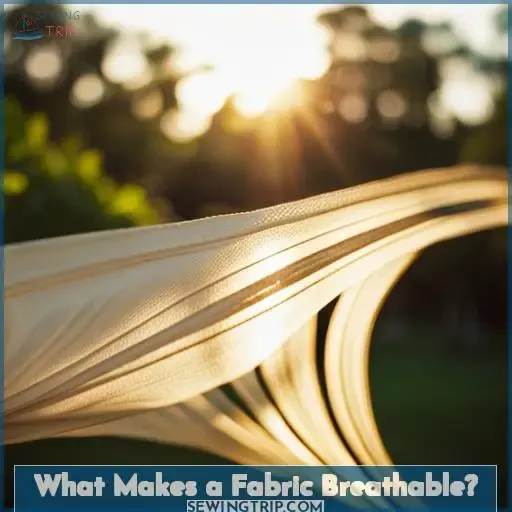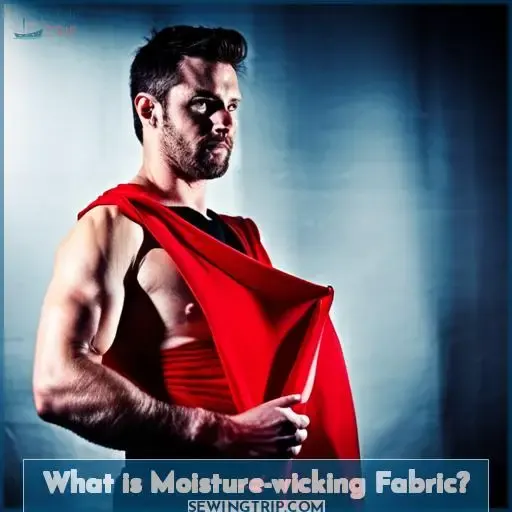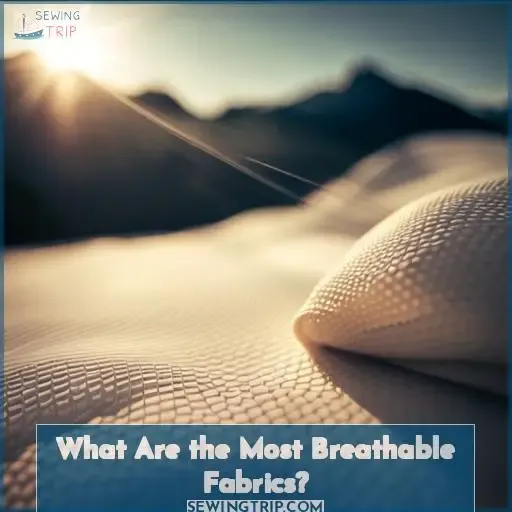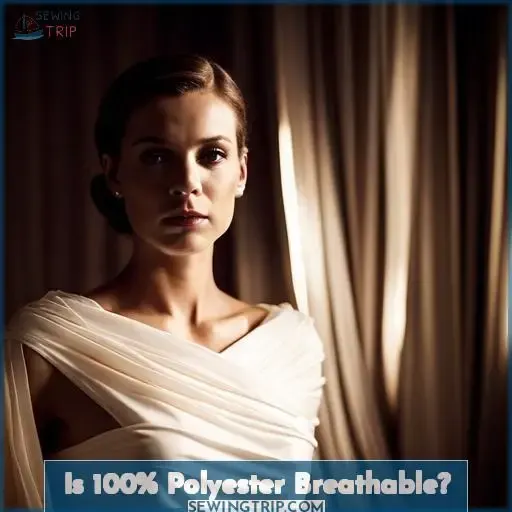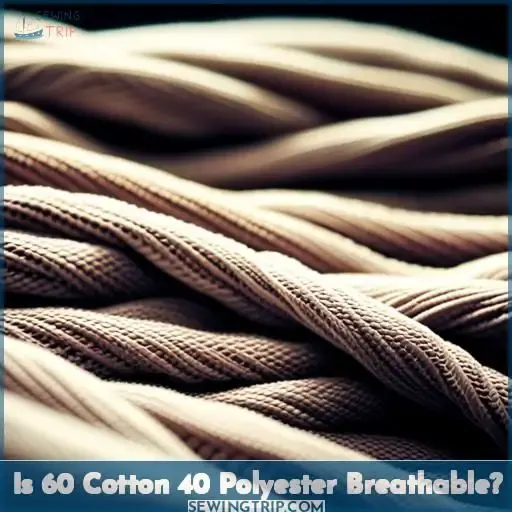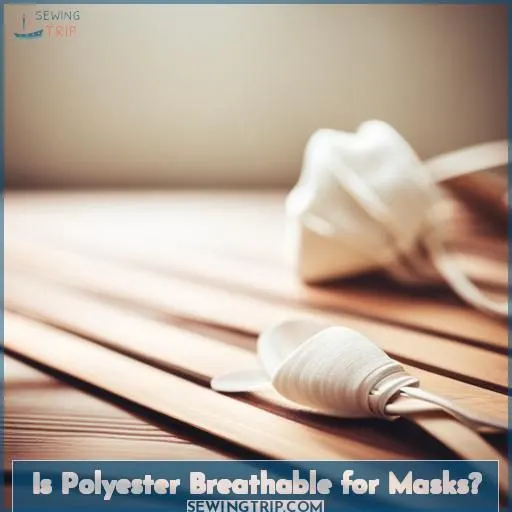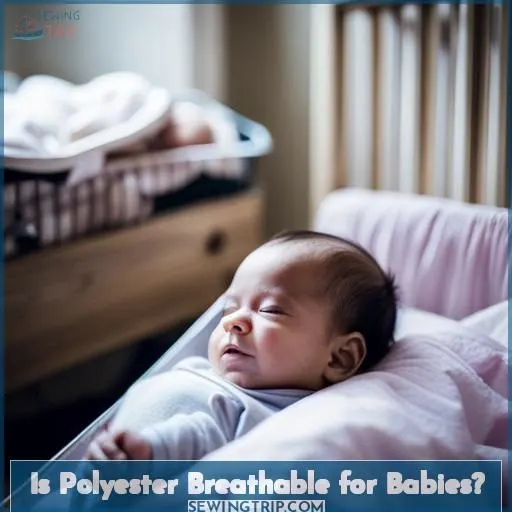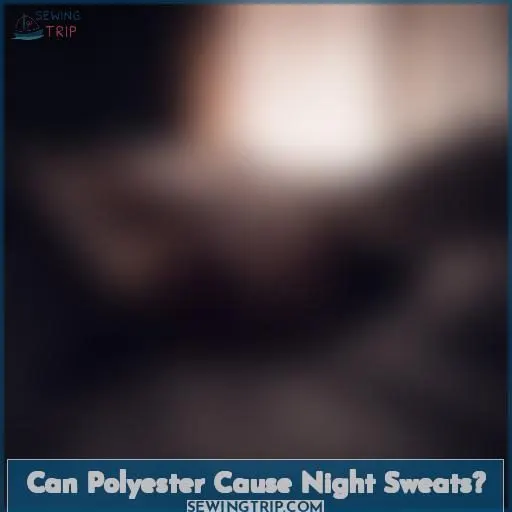This site is supported by our readers. We may earn a commission, at no cost to you, if you purchase through links.
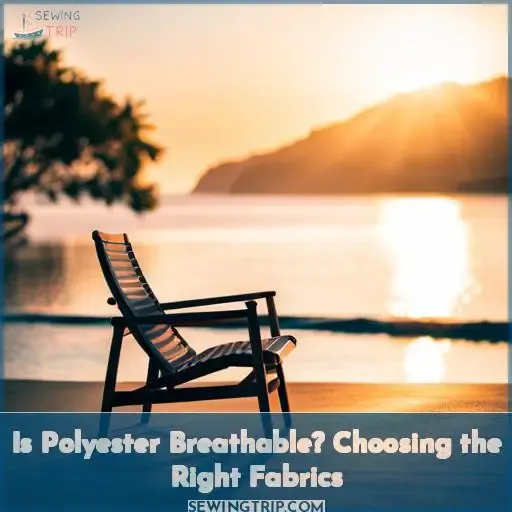 When the weather heats up, it can be difficult to stay cool and comfortable. You need breathable fabrics that will keep you feeling refreshed on hot days.
When the weather heats up, it can be difficult to stay cool and comfortable. You need breathable fabrics that will keep you feeling refreshed on hot days.
Is Polyester Breathable? We take a look at 9 different fabrics to help you stay cool in summer, including cotton, linen, jersey chambray, and rayon. We also discuss fabrics that are less suitable for hot weather, such as silk, polyester denim, and spandex fleece velvet or down.
Learn more about how these materials can affect your comfort temperature-wise so you can make the best choices when selecting clothes for warm temperatures!
Table Of Contents
- Key Takeaways
- What Makes a Fabric Breathable?
- What is Moisture-wicking Fabric?
- What Fabric Does Not Show Sweat?
- What Are the Most Breathable Fabrics?
- What Are the Least Breathable Fabrics?
- Is 100% Polyester Breathable?
- Is 60 Cotton 40 Polyester Breathable?
- Is Polyester Breathable for Masks?
- Is Polyester Breathable for Babies?
- Can Polyester Cause Night Sweats?
- Frequently Asked Questions (FAQs)
- Conclusion
Key Takeaways
- Polyester is not as breathable as natural fiber fabrics like cotton and linen.
- Polyester can trap heat and cause discomfort in hot weather.
- Blending polyester with natural fibers can increase breathability.
- Polyester can be made more breathable with quick-dry treatments or moisture-wicking technology.
What Makes a Fabric Breathable?
When it comes to staying cool and comfortable in hot weather, you want fabrics that allow your body’s moisture to evaporate quickly, like natural fibers or man-made moisture-wicking fabric. Breathable fabrics such as cotton, linen, and rayon are cooling fabrics that wick away sweat from the skin while hiding any perspiration lines.
These breathability benefits come at a cost; synthetic materials such as polyester do not absorb much of your body heat, so they can be uncomfortable during summer months. However, there are alternatives available for those who don’t want to sacrifice comfort when temperatures rise – Merino wool is an excellent choice due to its lightweight construction, which allows air circulation through the garment without trapping heat next to the wearer’s skin.
Natural fibers have always been seen as one of the best options for keeping cool, but more recently, man-made fabric with advanced properties has become popular too. These often feature a quick-dry treatment, which helps release built-up moisture faster than untreated material would do naturally.
Despite this technology being designed specifically for excessive perspiration problems, garments made from treated cloth tend not to be overly breathable. However, they still offer some relief compared with traditional polyester-based clothing items, making them suitable alternatives in summer conditions if desired style demands it.
What is Moisture-wicking Fabric?
You’re probably familiar with moisture-wicking fabric – it’s the type of fabric that quickly absorbs and releases sweat, keeping you cool and dry even on hot summer days.
There are a few key elements to consider when looking for a tee that will provide maximum performance:
- Natural fibers like cotton or linen are great at wicking away body heat, while polyester blends add quick-dry treatment to further enhance breathability.
- Bamboo is thought by some as being cooling too, but its overall performance may not be as good compared to other fabrics.
- Polyester does not absorb much of your body heat, so it’s best avoided in hot weather conditions.
- Merino wool offers lightweight construction and air circulation without trapping too much heat against your skin.
- Viscose is another option which features delicate fibers designed specifically for excessive perspiration problems.
Regardless of what you choose, look out for garments made from breathable natural fiber fabrics such as cotton or bamboo instead of polyester if staying cool is your goal! A combination of both can help create an optimal balance between form-fitting style choices and comfort during summer months.
Make sure whatever material you opt for allows the sweat produced by hard work or intense activities to evaporate easily – this way you won’t have any issues with dampness accumulating around areas where moisture tends to pool up like underarms.
With these tips in mind, enjoy every moment whenever wearing clothes tailored specifically towards enhanced breathability!
What Fabric Does Not Show Sweat?
To camouflage sweat, opt for natural fiber fabrics like cotton or linen blended with moisture-wicking polyester and nylon for optimal performance. For sweatproofing tips, look no further than man-made fiber fabric and ultra-thin man-made material that can quickly absorb body moisture while allowing it to evaporate easily.
Quick-dry treatments also enhance the fabric’s ability to release moisture from its surface – just keep in mind that treated garments tend to be more form-fitting than breathable.
For a truly effective combination of style choices along with comfort during hot summer months, choose materials such as bamboo or viscose, which feature delicate fibers designed specifically for excessive perspiration problems.
When working out outdoors or participating in high-intensity physical activities indoors, always opt for highly breathable workout fabrics over those made of synthetic materials like polyester due to their lack of absorption qualities when it comes to perspiration issues.
To take your protection against heat one step further, make sure your clothes are paired up with a good face mask!
In short, choosing the right material is essential if you want maximum performance in terms of protecting yourself from sweating profusely without compromising on how fashionable you can get! Natural fibers offer wicking away body heat while blends add quick-dry treatment.
What Are the Most Breathable Fabrics?
You may be wondering what the most breathable fabrics are when it comes to keeping cool and comfortable in hot weather.
Cotton, linen, jersey, chambray, and rayon are all popular choices for their ability to keep you feeling fresh even during sweltering days.
Cotton is known as one of the best natural fibers for its airy quality, while linen offers a breezy alternative with added strength.
Jersey is made from either cotton or a combination of cotton-polyester blend that provides breathability without sacrificing style.
Chambray keeps you light on your feet with its lightweight fabric construction featuring delicate threads derived from plants like rayon for an extra touch of comfort!
Cotton
Cotton is the most natural fabric for breathability; it’s light and breezy, allowing your body to stay cool. Cotton Care blends pure cotton with other fibers to make ultra-lightweight materials like wool scarves that are sweatproof in summer.
Cotton Comfort blankets use a polyester bedding blend or cotton-polyester mix, creating an airy layer of warmth perfect for any season.
Linen
You’ll love the cool, breezy feel of linen – a natural fiber fabric that helps keep you dry and comfortable in the summer heat. Linen is lightweight and breathable, allowing body heat to escape while providing full coverage for those with excessive perspiration.
It’s softer than cotton yet has similar properties to rayon or viscose fibers, like bamboo fabric. Merino wool mixed with linen can create a natural fiber blend perfect for when temperatures rise! Stay stylish and sweat-free this season without sacrificing comfort, thanks to the power of linen vs cotton options.
Jersey
Jersey fabric is a popular choice for warm weather, as it’s made from either cotton or a cotton-polyester blend and is breathable. Quick-dry treatments enhance its performance in releasing moisture, while natural fibers wick away sweat.
Polyester blends are perfect for night sweats and go-to jeans, but not so great when it comes to summer heat – polyester isn’t very breathable, despite some variations being moisture-wicking.
Chambray
Chambray offers a lightweight alternative to both heat and moisture, allowing you to stay cool in sweltering temperatures. It is crafted with a blend of cotton and polyester, making it durable enough for daily wear yet still breathable enough for comfort.
The styles of chambray vary from loose tank tops to skinny jeans, and its colors range from bright whites to deep blues. Additionally, thanks to its variety of spandex content options, there are different weights of denim available too! Not only does chambray provide great fabric performance, but it also helps keep the outside atmosphere away so you can enjoy looser garments without feeling stuffy or trapped by the heat.
Rayon
Rayon is an ideal choice for summer when you need something light and airy. Its delicate fibers keep you comfortable in hot weather, while still providing a cool feeling. Rayon’s sweat-wicking properties make it great for those who perspire excessively; its quick-dry treatment helps evaporate body moisture.
Natural fibers are also breathable, but may not camouflage excessive sweat like polyester blends or Merino wool do.
What Are the Least Breathable Fabrics?
You may not realize it, but certain fabrics can be more or less breathable than others. Silk, polyester, denim, spandex, fleece, velvet, and down are all materials that you should avoid when trying to stay cool in hot weather.
Silk has a tendency to show sweat stains prominently and does not offer much breathability. On the other hand, polyester is moisture-wicking but doesn’t allow for adequate airflow. Similarly, both denim and spandex trap heat, which can make them uncomfortable choices in hot temperatures.
Finally, fleeces, as well as velvets and downs, don’t let air flow through their fibers easily, making them poor options for summer wear too.
Silk
Although silk is often seen as a luxurious fabric, unfortunately, it doesn’t keep you cool on hot days – it actually showcases sweat stains and isn’t very breathable. Its delicate fibers make stain prevention difficult without quick-dry treatment, which sacrifices some of the more breathable nature of the fabric.
Polyester
Not ideal for summer days, this man-made fabric is a poor choice when it comes to breathability. Investing in breathable fabrics will help keep your body cool and comfortable during the warmer months. Polyester does not absorb moisture well, and its quick-dry treatments don’t make up for synthetic fabric drawbacks.
Natural fiber alternatives like wool or linen are the best bets due to their great characteristics, such as moisture-wicking technology, which helps keep you dry even on hot days! Avoid polyester when looking for something light, airy, and sweat-free during the summer – there’s a good reason why it’s so popular in colder seasons!
Denim
You’ll definitely feel the heat in denim, as this heavy fabric traps sweat and isn’t breathable. From chambray comfort to rayon resilience, other fabrics offer better potential shirt purchases. Plus, merino wool benefits like wicking away moisture make it a great source of relief for your night sweats too! Sports teams favor polyester for its durability, while light scarves made with bamboo provide cooling relief without sacrificing style.
Spandex
Spandex is moisture-wicking, but it’s not the most breathable fabric. It traps heat and will leave you feeling uncomfortable on a hot summer day. Forgo spandex for your favorite summer dress – there are lots of fabrics that offer better cooling relief! Natural fibers like cotton or bamboo in their purest form make great alternatives to traditional bedding items and face masks too! Beat the heat with breathable fabrics, quick-dry treatments, and natural fiber blends – they’ll keep you cool all season long.
Fleece, Velvet, or Down
Fleece, velvet, and down are no fun in the summer heat – they’ll leave you feeling trapped like a caged animal! These wintry fabrics trap body heat and parking lot air, making those hot summer nights seem even more unbearable.
Not only that, but many of these materials contain toxic chemicals that can be released into your skin when exposed to warmer temperatures.
Is 100% Polyester Breathable?
Despite its moisture-wicking capabilities, 100% polyester isn’t the best choice for hot weather as it doesn’t allow air to circulate freely and can trap heat.
- Opt for breathable fabrics like cotton or linen that provide comfort and keep you cool during the day while giving you a good night’s sleep.
- Choose natural fibers over synthetic ones – wool, bamboo, and muslin all have wicking properties but are lightweight enough to be comfortable even in summer temperatures.
- Avoid wearing too many polyester items together – they don’t breathe well when layered so mix them up with other materials such as rayon or viscose if needed!
With these tips in mind, your outfit will not only look stylish but also be more breathable than any polyester option could ever be!
Is 60 Cotton 40 Polyester Breathable?
You’ll stay cool and comfortable in a 60% cotton, 40% polyester blend – the perfect combination of breathability with durability. Blending polyester with natural fibers can help reduce heat trapping effects and increase comfort in hot temperatures.
Merino wool is often used for this purpose as it’s both breathable and lightweight while providing a good night’s sleep during cold weather months.
Summer fabrics such as rayon, viscose, or bamboo are ideal choices when looking to avoid obnoxious sweat stains without sacrificing style.
While the majority of sheets at stores contain some form of synthetic fiber like polyester these days, the perfect factor comes from having just enough cotton blended into them to keep you feeling airy on warm nights!
With all these benefits combined together for one fabric type, it’s no surprise that 60/40 blends have become so popular among those who like their clothing light yet durable.
Is Polyester Breathable for Masks?
While it’s not the lightest fabric, polyester can be an effective material for masks as its moisture-wicking properties help keep you dry and comfortable. It is important to choose a mask that fits well in order to optimize airflow and heat transfer.
A 60/40 cotton blend may offer superior comfort when compared to polyester alone, but if you’re attending an important meeting or going out for the evening, then polyester might be your best choice for keeping sweat under control.
Additionally, some people opt for absorbent plastic inserts inside their masks, which can further reduce perspiration buildup while providing a good night’s sleep during hot summer days.
Overall, choosing the right fabric when selecting a face mask is essential – both from a health perspective and also with regards to comfort levels throughout wearability periods! The best thing about using either cotton or polyester blends is that they wick away body moisture effectively without trapping heat against your skin like other materials such as fleece or velvet do.
Is Polyester Breathable for Babies?
For babies, it’s important to choose fabrics that are lightweight and moisture-wicking so they can stay comfortable even in warm weather. Cotton is a good summer choice for baby clothing as the breathable fabric helps regulate temperature without trapping heat against their skin like other materials such as fleece or velvet do.
Additionally, cotton has anti-irritant properties which help reduce any potential skin irritation caused by sweat buildup.
For maximum comfort during hot days outdoors, polyester is also an option – but should be blended with natural fibers or treated with quick dry technology in order to provide the best results when it comes to moisture control and fit of clothing items worn by infants.
In addition, lighter weight garments made from rayon or bamboo offer a breezy alternative while still providing adequate breathability for little ones who may be prone to night sweats – often the only source of relief on particularly humid nights! With its delicate fibers and cooling qualities combined with excellent durability over time – these materials make great choices when seeking out more appropriate attire for young children during those sticky summer months!
So if you’re looking for something that will keep your baby cool all season long at home or away– look no further than these natural fiber fabrics designed specifically with temperature concerns in mind!
Can Polyester Cause Night Sweats?
Though not ideal for summer, polyester can contribute to night sweats if it’s not blended with natural fibers or treated with quick-dry technology. Polyester is a synthetic fabric that doesn’t absorb body moisture as well as other fabrics.
This means that sweat can easily form on the surface of the material and cause uncomfortable heat retention during sleep.
Night sweat causes are often out of our control; however, some people may be more susceptible than others due to their genetics or lifestyle habits like drinking alcohol before bedtime.
If you’re still looking for something made from polyester but want less synthetic feel, there are plenty of options available at JoAnn Fabric & Craft Store – such as rayon and bamboo blends which offer lightweight comfort without compromising breathability in hot weather conditions! They also help keep your body temperature regulated throughout the day and/or evening hours when sleeping too much isn’t an option – making them perfect alternatives for those who don’t want to risk feeling clammy due to excessive perspiration after dark!
Ultimately though, only you know what works best when trying to answer can polyester cause night sweats? So make sure whatever choice you make keeps your nights comfortable all season long!
Frequently Asked Questions (FAQs)
What is the difference between breathable and moisture-wicking fabric?
Breathable fabrics allow moisture to evaporate, while moisture-wicking fabric absorbs it. Looser garments are generally more breathable, and man-made wicking is designed for excessive sweat. Quick-dry treatment enhances performance but makes clothes less breathable. Natural fibers can hide sweat lines better than polyester or nylon blends.
Cotton, linen, rayon, and jersey are all cooling options with varying degrees of breathability.
Is polyester good for wear and tear?
Yes, polyester is great for wear and tear. It’s known for its durability, making it a popular choice among fashionistas who want their garments to last. Its resistance to wrinkles and fading makes it ideal even in challenging climates.
Is it better to avoid wearing polyester in hot weather?
Yes, it is better to avoid wearing polyester in hot weather. Polyester does not breathe well and traps moisture, creating an uncomfortable environment for the body. Natural fibers are a much more suitable choice as they allow air to flow freely and wick away sweat effectively.
Are there any fabrics that are both breathable and sweat-resistant?
Yes! Fabrics like cotton, linen, rayon, chambray, and bamboo are breathable while also providing some sweat resistance. Man-made moisture-wicking fabrics offer more protection from perspiration than natural fibers.
Does blending polyester with natural fibers improve its breathability?
Blending polyester with natural fibers can improve breathability, but it is not a guarantee. The combination of fabrics may be better for wear and tear, but it still traps heat and moisture close to the body in hot weather.
Conclusion
The verdict on polyester is that it’s not the ideal fabric for hot weather. It traps moisture and heat and doesn’t allow for breathability. However, if blended with natural fibers, it may provide some degree of breathability.
The best fabric choices for summer are cotton, linen, jersey, chambray, and rayon. While these fabrics are more breathable, they can still showcase sweat stains. On the other hand, silk, polyester, denim, spandex, and fabrics like fleece, velvet, and down should be avoided as they’re not breathable.
To avoid night sweats, look for lightweight and natural fabrics that are breathable and wick away moisture.
In conclusion, polyester isn’t the best choice for those hot summer days, so don’t be caught in a sticky situation!

